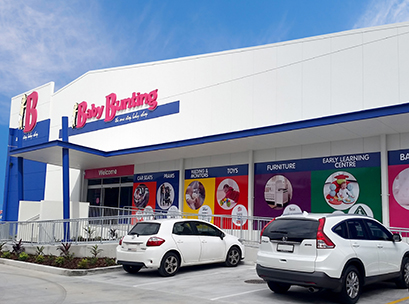 Baby Bunting has become the second big-box retailer in as many days to suffer with investors after it warned of a slow-down in FY18 trading on Friday morning.
Baby Bunting has become the second big-box retailer in as many days to suffer with investors after it warned of a slow-down in FY18 trading on Friday morning.
Shares in Baby Bunting Group dropped more than 15 per cent in the hours after CEO Matt Spencer delivered the company’s full-year result to the market, following a 9 per cent dip in Nick Scali’s share price after its results on Thursday.
Spencer had a good story to tell about the past-year, posting a 17.4 per cent increase in total sales to $278 million, while comparable store sales were up 6.9 per cent.
Earnings before interest, tax, depreciation and amortisation (EBITDA) increased by 40.6 per cent to $22.1 million, underpinning a 47 per cent spike in net profit to $12.2 million.
But it was the outlook that investors focused on, with same store sales growth down 4 per cent to the period ended 6 August and EBITDA guidance of between $25.3 and $27 million forecasted for FY18.
Spencer and chief financial officer Darin Hoekman were repeatedly quizzed on the nature of the guidance by investors and analysts on Friday morning, with concern expressed over the nature of the $7 million in capital and operating expenditure flagged for the coming financial year.
Spencer said the investment will be directed at measures to improve Baby Bunting’s digital offer and supply chain practices to ensure the company is up to the task of competing against Amazon.
“We have a very disciplined approach to cost management in our business and we have a very clear strategy, but given we’ve seen the imminent arrival of Amazon we’ve decided to bring forward some of our investment – most notably in systems, digital and supply chain capabilities,” Spencer said.
“These are long term strategic decisions that will strengthen our capabilities.”
The company has recently invested in new customer relationship management (CRM) and automated marketing platforms, alongside the creation of a new senior digital role in the business to drum up online purchases, currently sitting at just over 6 per cent of total sales.
A new supply chain management role has also been created as part of a “detailed review” into logistics, with an eye on increasing direct sourcing to expand the availability of exclusive lines and private label products.
Private label sales currently represent just over 11 per cent of Baby Bunting’s business, a figure Spencer hopes to increase to 25 per cent in the long term through soft-goods, car seats, containers and strollers.
It’s also shifting its price base, moving popular baby-seat lines onto its everyday low-price program to ensure it can match the e-commerce giant’s competitive price proposition.
“We wanted to make sure customers could be confident in our pricing model, so we’ve moved to an EDLP for our car seats,” Spencer said. “In a world where Amazon is in the market they don’t drive prices, but they will be the lowest price on the market so we’ve decided to take a leadership position on this now.”
The moves are informed by research Baby Bunting has pulled together on Amazon’s expected impact on the market, which predicts that the e-commerce giant will capture $135 million of the total $2.4 billion market in conjunction with existing marketplace provider Ebay.
The research was informed by category experience from the US, Canada and the UK, with management concluding that maintaining a high-service focus that leverages Baby Bunting’s store portfolio is the right play against the giant.
“Baby’s R US were in a very dominate position in the United states and Canada, using the high service model,” Hoekman told investors. “They pulled that model and lost market share to Amazon, while at the same time Buy Buy Baby opened a 120-store network and grew sales to $1 billion using that high service model.”
Management reckons that 80 per cent of Baby Bunting’s top 250 selling SKUs aren’t available outside of Australia, and that 56 per cent maintain a mandatory safety requirement that acts as a barrier to entry for new competitors.
Spencer, who inked a deal with Ebay last month, said that Amazon would likely need to use Baby Bunting’s suppliers to comply with product regulation, he stopped short of telling investors they’d look to sell on marketplace when it launches.
Regional shift
Having opened six stores during FY17, Baby Bunting has already opened one in the new financial year and intends to open another four-to-seven location as part of its long-term goal of 80 sites nationwide.
Currently trading in 42 stores, Spencer said the company would be focusing increasingly on regional locations, of which it currently has two, with one regional location to open in the first half of FY18 and another to open in the second half.
Regional locations will represent 43 per cent of Baby Buntings future store expansion plans, which means that the one stop baby shop is slated to open another 15 regional locations in the coming years.
Spencer also revealed that at least one of Baby Bunting’s FY18 stores will open in a Masters site, but declined to provide any further detail to analysts on what commercial terms had been decided only a day after Nick Scali managing director Anthony Scali indicated he’ll open in several Masters locations in the coming months.
Access exclusive analysis, locked news and reports with Inside Retail Weekly. Subscribe today and get our premium print publication delivered to your door every week.





